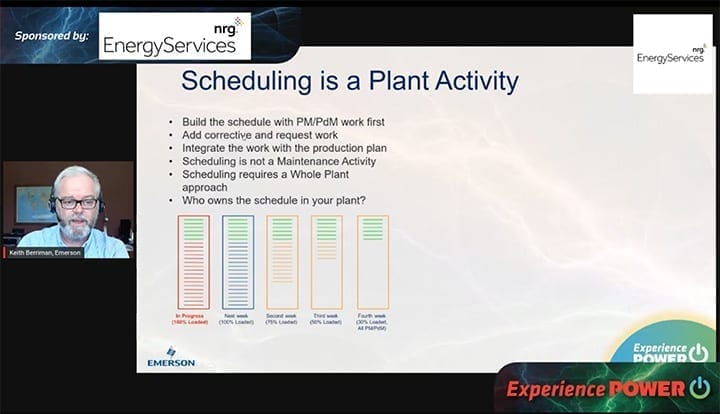How to Effectively Manage Power Plant Maintenance
The post How to Effectively Manage Power Plant Maintenance appeared first on POWER Magazine.

If you've worked in the maintenance department at a power plant, you know how important planning and scheduling are to success. There's an old saying that goes, plan the work, and work the plan." Effective teams do that well, but it's not easy.
Planning drives scheduling, not surprisingly, but planning is not scheduling," Keith Berriman, engagement director with iSolutions, an Emerson company, said during an Experience POWER conference session on Sept. 30 (Figure 1). So, it's not scheduling-it's not building the schedule-but without good planning, you can't build a good schedule, because we don't know how long the job will take, we don't know how many people we need, we don't know who's got the crane, all of those things."
 Keith Berriman said, Scheduling is a plant activity." In other words, maintenance scheduling needs to be performed as a cooperative task. Source: Experience POWER
Keith Berriman said, Scheduling is a plant activity." In other words, maintenance scheduling needs to be performed as a cooperative task. Source: Experience POWERBerriman said the idea of planning is to improve tool time," that is, the time workers are actually using wrenches to get a job done, rather than spending time on other activities. In a separate Experience POWER presentation, Ricky Smith, vice president of World Class Maintenance, shared results from a utilization survey that identified the main obstacles to high tool time. Among the time-wasters were: looking for tools, looking for parts, waiting on others, waiting on equipment, waiting on the supervisor, looking for specifications, and waiting on permits. Smith said world-class wrench time" is 55% to 65%, which means there's a lot of room for improvement, even in the best organizations.
Smith said a simple explanation of an effective process is scheduling of maintenance, operations, contractors, engineering, and safety personnel to be in the right place at the right time for the right work synchronized together as intended to minimize interruption to operations and production. You know, performing the right work, at the right time."
Berriman offered the following takeaways to make that happen:
- Build your improvement program on a strong foundation.
- Technology and tools are no substitute for a robust process.
- Add tools to build the future view of the process.
- Automate the process to take people out of the loop.
Berriman concluded his presentation by reviewing a four-quadrant maintenance management model (Figure 2), developed based on Stephen R. Covey's time management matrix featured in his book The Seven Habits of Highly Effective People. Berriman explained, We want to spend our time in quadrant two. So, we want to have planned, preventive, predictive, proactive maintenance." However, he said, most people are too busy in quadrant one.
 Berriman said the four-quadrant maintenance management matrix has proven to be a very effective communication tool. Source: Experience POWER
Berriman said the four-quadrant maintenance management matrix has proven to be a very effective communication tool. Source: Experience POWERSo, how do we do that? Well, the way we do that is to start [in the two lower quadrants] and eliminate the time we spend doing the wrong work and the rework, and doing the wrong PMs [preventive maintenance tasks]," he said. So, clean out our PMs, write better plans, execute those better, and then the reactive work starts to go down. [Then] we can spend more time [in quadrant two]."
-Aaron Larson is POWER's executive editor (@AaronL_Power, @POWERmagazine).
The post How to Effectively Manage Power Plant Maintenance appeared first on POWER Magazine.